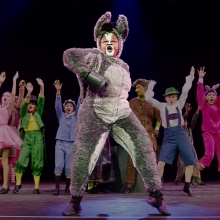Filichia Features: Violet: Let It Sing
Filichia Features: Violet: Let It Sing
 Violet -- the 1997 off-Broadway hit that became this year’s Tony-nominated revival – just closed on Broadway this past weekend.
Violet -- the 1997 off-Broadway hit that became this year’s Tony-nominated revival – just closed on Broadway this past weekend.
But the tuneful and heart-rending show will continue to affect the country at large, as long as there are resourceful directors such as Marty Strohmeyer and Sarah Hairston. They collaborated on a production that was a big hit in June at the Thespian Festival in Lincoln.
Strohmeyer and Hairston are St. Louis directors; he teaches at Visitation Academy while she works at Chaminade College Preparatory School. There’s an irony here; the man teaches at an all-girls’ school and the woman at an all-boys’.
So, you’re inferring, Visitation provided the girls for the Jeanine Tesori-Brian Crawley musical and Chaminade the girls. Not at all. The two directors opened the casting to any Missouri high school that has an International Thespian Society troupe. Of the dozens upon dozens of kids who answered the call, 21 students from 15 schools made the cut. Three student musicians were engaged with four pros to play Tesori’s Southern-tinged music.
Seventeen others, from teens to adults, gave technical support, including graphics designer Thomas Hairston. He, you’ll notice, has the same last name as one of the directors. Well, has there ever been a high school production where someone’s husband or wife hasn’t been dragged in to lend some sort of help?
The directors couldn’t be accused of playing favorites. A look at the program (printed, of course, on violet paper) showed they didn’t cast any of their own in the five leads.
Courtney Fortner of Parkway South High played the title character: Violet Karl, now a twenty-something young woman who, as a child, had her face forever scarred after her father’s axe blade slipped off its handle. Violet rues “People look at me and think that’s all there is to me,” a line that Fortner reminded us was universal; like it or not, we’ve all felt at times that many people have judged us simply by the way we look.
What’s worse, Violet takes place in 1964, when a woman’s worth – and marriageability – was most determined by her appearance. Strohmeyer, who also designed the costumes, wisely put Violet in a high-necked long dress. No, the axe didn’t affect any other part of her body, but this ultra-conservative dress reiterated that Violet doesn’t feel attractive.
The directors splendidly had their actors offer the right expression when each saw Violet for the first time. All of them looked at her long enough to pretend that nothing was wrong, and some gave slight little smiles of “Hello.” Unfortunately, they couldn’t hold the pretense; seeing a young woman so disfigured ultimately crossed their pain threshold, and they soon darted their eyes in a different direction. Even those with stronger stomachs eventually looked away because that was the polite thing to do. The
However, the writers decided to deal with Violet’s scar the same way that playwright Bernard Pomerance treated his title character in The Elephant Man. They too decided not to show any ugliness, but let the audience imagine it. So just as Lauren Ward in 1997 and Sutton Foster this year looked beautiful, so did Fortner.
Unlike The Elephant Man, however, Tesori and Crawley would eventually give a flashback seconds after the accident, when Violet’s face had a wide gash from which blood was pouring. This is an especially smart coup de théâtre; after we’d been lulled into assuming we wouldn’t see anything particularly unsettling, we were given it.
Actually, seeing the fresh wound was far worse than a healed-but-scarred face. That we saw it on Young Violet (an excellent Abigail Isom) made the horror even greater. Thus, when you do the show, make certain that the flashback of the split face is severe enough to make The Phantom of the Opera seem like Gaston in Disney's Beauty and the Beast.
Even before the accident was revealed, Richard Langbartel of Parkview High showed Father’s anguish. He will never stop blaming himself for the accident but he tries to pretend it’s behind him. That way, his daughter might not continually think of how bad her face and fate are. As a result, Father often sends her to the movies so that she can escape into Hollywood fantasies – where the dark will cover her.
Still, Violet doesn’t want to go through life with a bifurcated face, so she’s now on a bus that will take her from her native North Carolina to Oklahoma. She believes that a preacher there will, with the help of God, make her face beautiful. How well Fortner played this hope and dream, which made our hearts break because we knew that God wouldn’t help.
Fort Zumwalt South High’s Benjamin Stanley played Preacher as secure and seemingly devout – at least until he met Violet and realized how much she was depending on him. Then he was tender in letting her see that he didn’t have the power she’d expected him to have.
And yet, the trip is hardly a waste of time and money. On the bus, Violet meets thirtysomething black sergeant Flick (the solid Ralphel Johnson of North Tech High), and Monty (the estimable Trey Hale of Forsyth High), a white corporal who’s between Violet and Flick’s ages. Both men will ignore what’s wrong with her face and will vie for her hand. They know that Violet wouldn’t win a beauty contest, but they appreciate that she’d be a strong contender in a Miss Inner Beauty Contest if such a competition were to exist. (Come to think of it, somebody should start one.)
At first, Violet is reluctant to even touch Flick’s hand; many a white in those days -- be he from the North, South, East or West -- felt the same way. The writers also established Flick’s lifelong burden of being insulted to his face and having no choice but to take it. Flick’s situation reminded us that for blacks in 1964, the army was one of their best career moves -- even if they had to run the risk of being killed in Vietnam.
Not that a black man’s dealing with enlisted whites would be easy. True, the army had been integrated in 1952, but that didn’t mean immediate acceptance for every black soldier. Instead, he was more likely to encounter hostility from those who resented integration. Johnson showed a Flick who was prepared for the struggle.
Violet soon got a taste of Flick’s life. When they attended a dance, the white couple in charge was indignant at seeing the two together – just as in the next scene a black innkeeper was equally incensed at the thought of a white woman dating a black man. Miscegenation laws would still be in place in all Southern states for at least two more years – not that their being repealed would then immediately make day-to-day living easy for a mixed-race couple. Both Fortner and Johnson conveyed that they were strong and ready to become pioneers in the nascent civil rights movement.
Times have indeed changed, for the teen-heavy festival audience in Lincoln applauded when Violet and Flick kissed. These students rooted for two characters they liked and didn’t care that they belonged to two different races.
One last thing: Violet brought on the bus a Baltimore Catechism, a book that, from the 1880s until the late 1960s, told students in meticulous detail what the Catholic Church demanded of them. Take it from someone who once experienced 12 years of Catholic schools: Strohmeyer and/or Hairston found the actual edition that was used in the early ‘60s. Yes, both Visitation and Chaminade are Catholic schools, but there can’t be too many vintage catechisms hanging around either campus.
God isn’t just in the catechism, but also, as we know, in the details. Strohmeyer and Hairston’s getting the right book also proved another religious-tinged maxim: the Lord helps those who help themselves (and directors’ attention to detail helps audiences, too).
 You may e-mail Peter at pfilichia@aol.com. Check out his weekly column each Tuesday at www.masterworksbroadway.com and each Friday at www.kritzerland.com. His new book, Strippers, Showgirls, and Sharks – a Very Opinionated History of the Broadway Musicals That Did Not Win the Tony Award is now available at www.amazon.com.
You may e-mail Peter at pfilichia@aol.com. Check out his weekly column each Tuesday at www.masterworksbroadway.com and each Friday at www.kritzerland.com. His new book, Strippers, Showgirls, and Sharks – a Very Opinionated History of the Broadway Musicals That Did Not Win the Tony Award is now available at www.amazon.com.

























